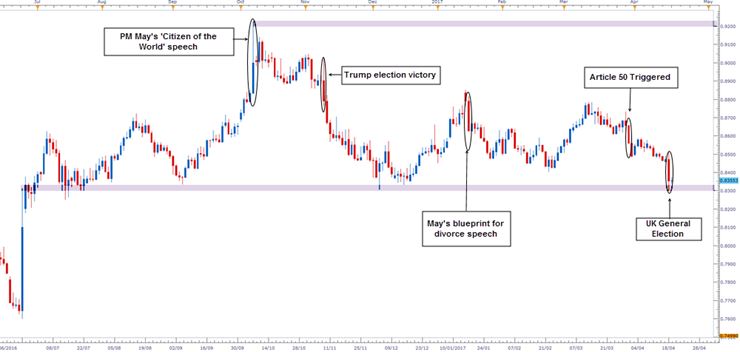Come with me and we’ll write that brighter future. Come with me and we’ll make that change. Come with me as we rise to meet this moment. Come with me and together let’s seize the day.
Lyrics from the first platinum single by Backstreet Boys / One Direction / a.n.o.t.h.e.r boy band? (delete as appropriate). Of course not! This is the final call to arms from Prime Minister May’s first Conservative Party speech she gave back in October of last year. Some dubbed this the ‘Citizens of Nowhere’ speech as the PM was accused of being overtly nationalist. Since that time, EUR/GBP has been kicked about like a political football with bouts of Brexit fear mixed in with French election concerns.
It is fascinating to look at a currency cross like this to see historical price action and what, if anything, it can tell us about future direction. What is crystal clear is that price expansion has obviously occurred far more around political events concerning the two currencies than other monetary policy issues. And this theme is undoubtedly set to continue as we head into the first round of French Presidential elections this weekend.
With some polls too close to call, the market has Macron and Le Pen as the slight favorites to win through to the second round of voting on May 7. There is much speculation, too, about the turnout in the first round and how it could affect Le Pen’s votes.
Short-Term Value
On the other side of the Channel, Mrs. May’s snap election bombshell on Tuesday was just that for EUR/GBP, which dropped the most since her Lancaster House speech — the ‘blueprint for divorce’ — in January. February lows were taken out and prices made an intraday low of 82.97. This is also the smoothed 200-day moving average, which is a critical level of long-term support. With both cable and EUR/USD consolidating after such large moves, the cross is pausing for breath. Interestingly, market positioning is important in this pair. Large shorts in GBP match up against relatively flat EUR positions, which means the single currency is more vulnerable in the short-term.
Of course, interest-rate differentials are normally one of the key drivers for currencies. In that light, a more dovish stance in next week’s ECB meeting would contrast with the Bank of England’s most recent gathering. This would tally with Wednesday’s confirmed Eurozone March inflation reading of 1.5% — the biggest monthly price drop in over a year and the stubborn core figure of just 0.7%.
Whatever happens, we know that politics will be a key driver in price action. If the consensus is correct, we could see a relief rally after the French first round. Going forward, maybe PM May will seize the day and drive the cross through the 83 barrier. That will most likely depend on the ‘smooth’ Brexit the market is now hoping for.

